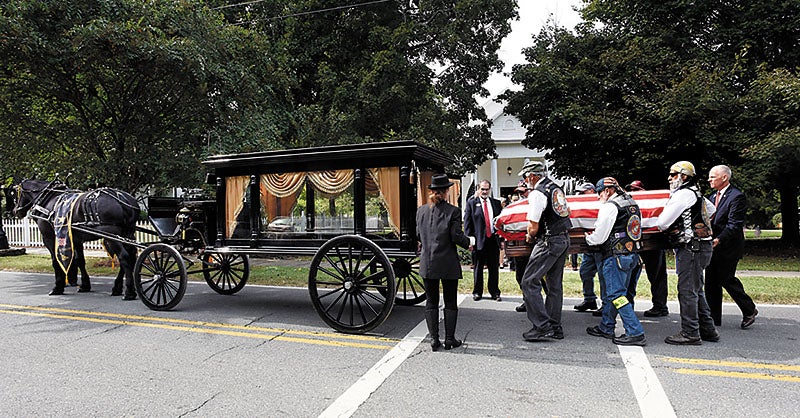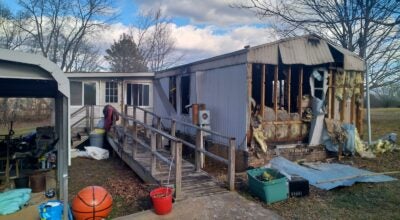A homecoming in Gold Hill: Service, burial held for airman lost 73 years ago
Published 12:10 am Monday, September 25, 2017

- Wayne Hinshaw / for the Salisbury Post The Patriot Guard loads the casket into the hearse. Capt. Lamar Russell died in a plane crash in 1944. His remains were recently located, and he was flown home to Gold Hill for burial.
GOLD HILL — There was an open casket Sunday for Capt. Lamar Shafer Russell, even though he died more than 73 years ago.
But it seemed the right thing to do. An Army dress uniform lay where you would normally expect the body of Russell.
Elsewhere, not seen, the flag-draped casket held pieces of Russell that had been recovered from a jungle mountainside in New Guinea. It was there, on Feb. 1, 1944, that a B25 in which Russell was a sick-leave passenger crashed, killing all 11 on board.
Sunday’s funeral service was held for Russell at Gold Hill United Methodist Church — his home church from long ago. And it was the right place to be.
The church was filled mostly with people Russell never had met, yet a handful he knew well, including his now 86-year-old sister, Patsy Yelton; her husband, John; and cousin Dr. Frank Shafer.
Russell had planned to attend medical school and become a doctor himself, but he went off to fight first. World War II would claim his life, then four months later in 1944, the life of his younger brother Ernest.
Standing near the casket prior to the service Sunday was Ernest Lamar Yelton, the nephew named for the uncles he never knew. Cousin Chip Shafer stood with him, saying he would not have missed the service for the world.
This was the right place for them.
A horse-drawn hearse carried Capt. Russell’s casket from the church to the Gold Hill Cemetery, about a half-mile away. Drew Barkley led the country-road procession, playing mournful songs on his bagpipes.
At least 20 members of the Patriot Guard, each holding an American flag, walked with the hearse as did some friends and family. Patsy and her immediate family rode in a funeral home limousine with them.
The procession passed the house where Russell had grown up. Patsy and John live there today.
At the cemetery, pallbearers from the N.C. National Guard took over, carrying the coffin from the hearse to its spot immediately in front of the Russell family’s monument. This also was where Ernest was buried after being killed on Saipan in the Marianas on June 15, 1944.
The Army detail folded the American flag covering Lamar’s casket and presented it to Patsy Yelton with gratitude from a nation and its president. The Rowan County Veterans Honor Guard fired their rifles in salute.
“Taps” was played on a trumpet. Lewis Reid, representing the Veterans Honor Guard, told the family it was because of men such as Russell we enjoy the freedoms we do.
And he was right.
“May you feel he is at rest and endless peace,” Reid told Patsy and the rest of her family.
Lamar Russell grew up in Gold Hill as the oldest child of Raymond and Beulah Russell. He was older than his baby sister Patsy by 14 years, but the two corresponded during the war.
After first going to Rockwell School, Lamar went to live with an aunt in Salisbury and attended Boyden High School for three years, then Catawba College for four.
The Rev. Dr. Ken Clapp, chaplain of Catawba College, said Russell recognized education would open doors for him.
Russell graduated from Catawba in 1939 and joined the Army Air Corps in 1940. He served in the headquarters of the 3rd Bombardment Group in the Pacific Theater during the war, and Gen. Douglas MacArthur awarded him the Legion of Merit in 1943 for “exceptionally meritorious” conduct in the performance of outstanding services as a photographer in New Guinea.
Russell developed a camera mount for taking minimum altitude oblique photographs, helping to solve the problems connected with snapping detailed pictures from aircraft flying at high speed and low altitude.
Russell contracted malaria in New Guinea, but reportedly was doing better when he boarded that flight Feb. 1, 1944, from Dobodura to Port Moresby. Bad weather forced the B25’s pilot to turn around that morning and head back toward Dobodura, but radio contact was lost about 7:30 a.m.
It wouldn’t be until 1961 that a Royal Australian Air Force team trying to find another downed plane would come across the 1944 crash site in the Owen Stanley Mountain Range near the Kenevi peak.
Because of the jungle and topography, recovery operations at that site would prove difficult. Some remains, identification tags, a bracelet and a ring were found, but none of the hardware belonged to Russell and none of the remains could be specifically connected to any of the 11 men who died.
In 1963, Patsy and her family attended a military funeral service for the 11 servicemen at Arlington National Cemetery, where there is a monument with their names. Two caskets were buried at that time.
It wasn’t until earlier in this century that more remains were found back on that New Guinea mountain by a third-party group. They were handed over to the Joint POW/MIA Accounting Command, which did further recovery work.
The Army asked Patsy and her son, Lamar, for DNA samples in 2014, and they learned in 2016 they were a match for pieces of a humerus, clavicles, a left scapula and a couple of cervical vertebrae unearthed at the crash site.
This summer, a representative from the the Casualty & Mortuary Affairs Operations Center at Fort Knox, Ky., traveled to Gold Hill and presented Patsy with her brother’s dog tags, which also had been found at the site.
Those dog tags were on display inside the church sanctuary Sunday, along with Russell family photos, newspaper clippings and a framed presentation of the medals both Lamar and Ernest had received during their military service.
The Army, in its constant efforts to bring those lost in any war home, paid for the transport of Lamar Russell’s remains from the Joint POW/MIA Accounting Command in Hawaii to Charlotte on Friday.
The Army also covered the cost of the service and burial. It was the right thing to do.
Asked to give the homily Sunday, Clapp said there’s something about human nature that values going home. Numerous passages in the Bible talk of homecomings. The ancient Greeks took great pains, too, to bring their fallen soldiers home to a final place of rest.
“We have gathered today to celebrate that homecoming,” Clapp said.
But throughout the day, given their faith, Clapp and the Rev. Beverly Maulden, pastor of the church, talked of a different kind of homecoming for Russell.
Clapp said it should not be forgotten that a far better homecoming was made possible Feb. 1, 1944, by the love of God, assuring Russell would have a heavenly home — that the love of God makes the supreme homecoming possible.
Maulden led the transferring of Lamar Russell’s membership in the little Gold Hill church to one much more important — “our church triumphant,” she said.
And it seemed right.
Contact Mark Wineka at 704-797-4263 or mark.wineka@salisburypost.com.


